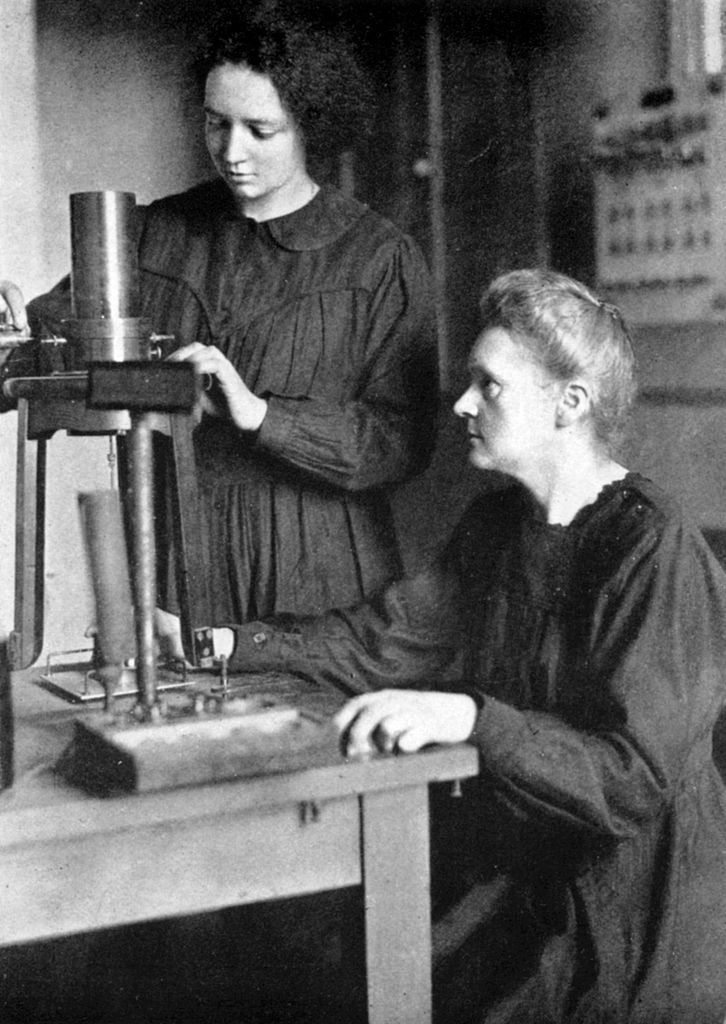 September 12, 1897, in Paris (France) – March 17, 1956, in Paris (France)
September 12, 1897, in Paris (France) – March 17, 1956, in Paris (France)
Daughter of Marie Curie (Nobel Prize in Physics in 1903 and Chemistry in 1911) and Pierre Curie (Nobel Prize in Physics in 1903), she showed her ability for mathematics from a very young age and studied at her own school, known as the Cooperative, together with other children of prestigious intellectuals in which their teachers were Marie Curie, Paul Langevin and Jean Perrin.
He finished his secondary studies at the Collegium de Sévigné, an independent school located in the center of Paris, and in 1914, he entered the Sorbonne University to study physics and mathematics. Due to the outbreak of the First World War in 1916, she stopped studying to work as a radiological nurse helping her mother. She also directed the development of X-ray diagnostic devices at military hospital facilities in Belgium and France for which she received the Military Medal after the war..
 In 1918, he became his mother's assistant at the Radium Institute (now known as the Curie Institute) in Paris and completed his doctoral thesis on the alpha rays of polonium. It is at this time that she meets and marries Frédéric Joliot in 1926 and they take the surname Joliot-Curie.
In 1918, he became his mother's assistant at the Radium Institute (now known as the Curie Institute) in Paris and completed his doctoral thesis on the alpha rays of polonium. It is at this time that she meets and marries Frédéric Joliot in 1926 and they take the surname Joliot-Curie.
Together with her husband, she began her research in the field of nuclear physics. They were looking for the structure of the atom and in particular the structure and projection of the nucleus, which was essential to later discover the neutron (1932) and the positron (1932). In 1934, they managed to artificially produce radioactive elements by bombarding boron, aluminum and magnesium with alpha particles (helium nuclei). They showed that certain isotopes are unstable and emit radiation as they decay, unlike natural isotopes, which are stable. Over time, it was found that any element that had one or more stable types of nuclei could also have radioactive nuclei.
This discovery changed the entire periodic table as more than 400 radioisotopes were added. Its concentration, isolation and availability allowed its use in medicine and research. It also changed the way of seeing chemical elements, the relationship between them, including the phenomena of fission of heavy nuclei into lighter ones or the fusion of lighter nuclei to form heavier nuclei.
In addition, they worked on chain reactions and the requirements for the proper construction of a nuclear reactor using nuclear fission.
In 1935, they were awarded the Nobel Prize in Chemistry for their work on the synthesis of new radioactive elements.
That same year, she was appointed research director of the National Science Foundation and the following year she achieved the position of Undersecretary of State for scientific research, but, in 1951, she was removed from the French Atomic Energy Commission due to her sympathies with the Party. French Communist. She was a member of the National Committee of the Union of French Women and of the Council for World Peace.
They had two children, Hélène, also a well-known physicist (she married Paul Langevin's grandson), and Pierre, who studied biochemistry.
In 1937 he got the chair at the Faculty of Sciences in Paris.
In subsequent years, the Joliot-Curie couple expanded their work with the identification of nuclear fission products and became involved in the debate on the social impact of the use of radioactivity.
He grew up in an environment of famous scientists, even his sister Eve Denise Curie became famous for the biography she wrote about her mother, which explains why only a part of her great achievements have been recognized and even despite obtaining jointly with her husband a Nobel Prize.
Both alone and in collaboration with her husband, she did important work on natural and artificial radioactivity, the transmutation of elements, and nuclear physics.
 September 12, 1897, in Paris (France) – March 17, 1956, in Paris (France)
September 12, 1897, in Paris (France) – March 17, 1956, in Paris (France) In 1918, he became his mother's assistant at the Radium Institute (now known as the Curie Institute) in Paris and completed his doctoral thesis on the alpha rays of polonium. It is at this time that she meets and marries
In 1918, he became his mother's assistant at the Radium Institute (now known as the Curie Institute) in Paris and completed his doctoral thesis on the alpha rays of polonium. It is at this time that she meets and marries 

